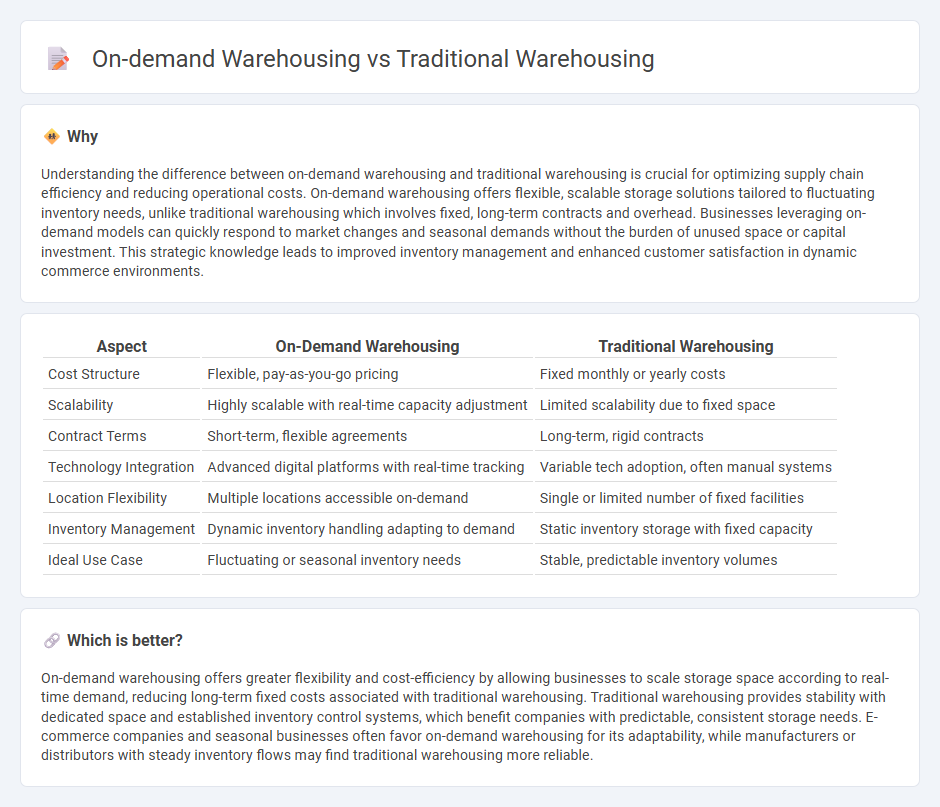
On-demand warehousing offers flexible storage solutions by allowing businesses to rent space as needed, reducing fixed costs compared to traditional warehousing that involves long-term leases and capital investment. It leverages real-time technology platforms to match supply with demand, enhancing scalability and operational efficiency. Discover how on-demand warehousing can transform your supply chain strategy.
Why it is important
Understanding the difference between on-demand warehousing and traditional warehousing is crucial for optimizing supply chain efficiency and reducing operational costs. On-demand warehousing offers flexible, scalable storage solutions tailored to fluctuating inventory needs, unlike traditional warehousing which involves fixed, long-term contracts and overhead. Businesses leveraging on-demand models can quickly respond to market changes and seasonal demands without the burden of unused space or capital investment. This strategic knowledge leads to improved inventory management and enhanced customer satisfaction in dynamic commerce environments.
Comparison Table
| Aspect | On-Demand Warehousing | Traditional Warehousing |
|---|---|---|
| Cost Structure | Flexible, pay-as-you-go pricing | Fixed monthly or yearly costs |
| Scalability | Highly scalable with real-time capacity adjustment | Limited scalability due to fixed space |
| Contract Terms | Short-term, flexible agreements | Long-term, rigid contracts |
| Technology Integration | Advanced digital platforms with real-time tracking | Variable tech adoption, often manual systems |
| Location Flexibility | Multiple locations accessible on-demand | Single or limited number of fixed facilities |
| Inventory Management | Dynamic inventory handling adapting to demand | Static inventory storage with fixed capacity |
| Ideal Use Case | Fluctuating or seasonal inventory needs | Stable, predictable inventory volumes |
Which is better?
On-demand warehousing offers greater flexibility and cost-efficiency by allowing businesses to scale storage space according to real-time demand, reducing long-term fixed costs associated with traditional warehousing. Traditional warehousing provides stability with dedicated space and established inventory control systems, which benefit companies with predictable, consistent storage needs. E-commerce companies and seasonal businesses often favor on-demand warehousing for its adaptability, while manufacturers or distributors with steady inventory flows may find traditional warehousing more reliable.
Connection
On-demand warehousing and traditional warehousing both serve as critical components in supply chain management, enabling businesses to store inventory efficiently. Traditional warehousing offers long-term storage contracts with fixed capacity, while on-demand warehousing provides flexible, short-term solutions that adjust to fluctuating inventory levels. Integrating these models helps companies optimize storage costs, enhance distribution speed, and improve inventory visibility across commerce operations.
Key Terms
Inventory Management
Traditional warehousing relies on fixed storage locations and long-term contracts, which can lead to underutilized space and inflexible inventory management. On-demand warehousing offers scalable storage solutions with real-time inventory tracking, optimizing space usage and reducing holding costs. Discover how integrating on-demand warehousing can streamline your inventory management and enhance operational efficiency.
Flexibility
Traditional warehousing involves long-term leases and fixed storage capacity, limiting flexibility in adjusting to fluctuating inventory demands. On-demand warehousing offers scalable, pay-as-you-go storage solutions that enable businesses to quickly adapt to seasonal spikes and market changes. Discover how on-demand warehousing can enhance your supply chain agility by learning more today.
Cost Structure
Traditional warehousing typically involves fixed costs such as long-term leases, labor, and utilities, leading to higher overhead expenses regardless of inventory turnover. On-demand warehousing offers a flexible cost structure with variable fees based on actual storage and handling needs, reducing unnecessary expenses and improving cash flow efficiency. Explore how each model impacts your logistics budget to choose the most cost-effective solution.
Source and External Links
What Is Traditional Warehousing- Concept, Benefits & Operation - Traditional warehousing involves storing goods in a permanent facility with organized palletized or shelved storage, managed by manual stock checks and simple inventory systems, focusing on order preservation and minimizing damage, ideal for large-scale businesses needing control over inventory management.
Pay-Per-Use VS Traditional Warehousing: Which is Right for Y - Traditional warehousing is characterized by long-term lease contracts and fixed costs, giving businesses exclusive control over warehouse layout and inventory management, enabling stable budgeting and tailored logistics.
Traditional Warehousing Vs Automated Warehousing - Traditional warehousing relies heavily on manual labor for stock picking and inventory management, with simple but higher-cost operations compared to automated warehouses, serving as a straightforward solution for many businesses.
 dowidth.com
dowidth.com